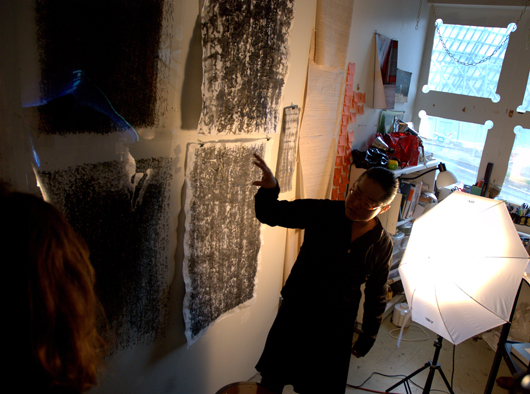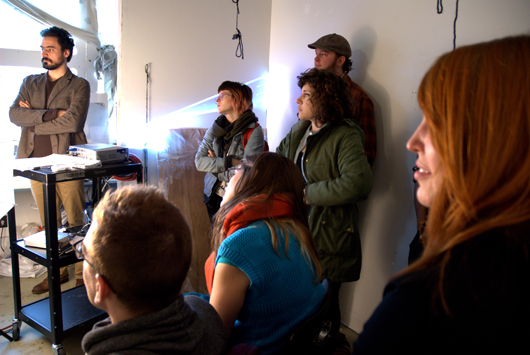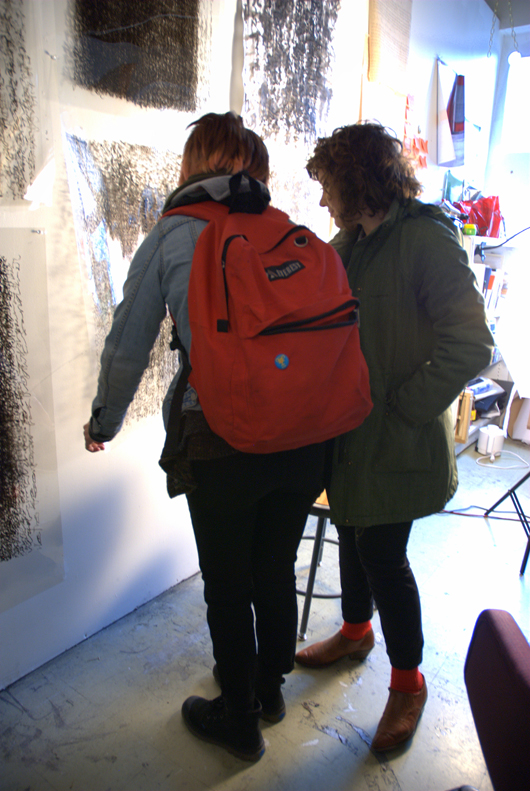Images of Life, Love, and Politics: Early Photography of Craig Hickman
“Portland Creative Community 1.0”
at the White Box, Fall 2013

As a young man of 17 in 1960s Portland, Oregon, Craig Hickman carried around a camera—without much in the way of rigorous intention and devoid of a strict or limiting sense of an impending project. Hickman, instead, gently wielded his Nikon- F pointing it at friends, lovers, places, and people, many times strangers, he saw around him. The camera operated as an extension of himself, a way to casually document day-to-day life and a way to capture moments that intrigued him. At times, fully immersed in a moment of fun and experimentation, he would hand his camera to a friend who would turn the lens on Hickman himself, producing an unprompted photograph of the photographer.

Hickman followed an early path that would continually fuel his passion for photography and would branch out to include his development of significant computer software (Kid pix), becoming a professor in the University of Oregon Digital Arts program (Department of Art) and a career as a successful, highly acclaimed photographer known for his playful and insightful integration of word and image, and the digital manipulation of images. In the 1960s and 1970s as a student, Hickman worked on the Portland State University yearbooks (yearbooks that with the influence of Hickman and his core cadre of comrades at PSU were artistically designed and intended more as “photobooks” than conventional yearbooks). These photobooks were lively publications rife with journalistic documentation of the assemblies and protests of 1960s, honest portrayals of student life and campus involvement, glowing and sensitive portraits of fellow students, at work, at play, in love.
Leaving PSU in the 1970s, Hickman continued his education and immersion in photography becoming a staff photographer at Evergreen State College (Olympia) and teaching courses at ESC in photography. Intertwined in these pursuits, Hickman would find the time to commute back and forth from Olympia to Portland to initiate and help launch Blue Sky Gallery along with close friends, Chris Rauschenberg, Ann Hughes, Bob DiFranco, and Terry Toedtemeier. Eventually, with Blue Sky set well on its way to emerging as an international, leading photographic gallery, Hickman decided to enroll in graduate school in the early 1980s and pursue studies towards a Master of Arts in photography from University of Washington.
From those early days of capturing unscripted, candid images, and from rarely being without a camera, Hickman’s circle of friends, his subjects, as it were, in most of his photos, explored Portland, New York, and the environs of the Pacific Northwest with an active and curious enthusiasm forming affections and attachments –some that would last and evolve over the next half century. It was a group of close associates in their 20-and 30-something years that included people like Tom Taylor (who would eventually bring about the establishment of the Northwest Film Center); Frank Foster (first head of computer graphics division at Sony Pictures); Chris Rauschenberg (co-founder of Blue Sky, son of Robert Rauschenberg, and himself a renowned photographer); Terry Toedtemeier (co-founder of Blue Sky, Portland Art Museum photographer curator, and lauded photographer); musician Linda Waterfall (folk musician and singer-songwriter); Lynda Winman (co-founder of Lynda.com); Lauren Van Bischler (founder of Portland’s The Real Mother Goose); and many more. These people formed the core of Hickman’s work during this period from the 1960s to the 1980s. It is a collection of images of which the original pictures were never printed nor inspected, until now that is, having been pulled from Hickman’s early career photographs to blanket the walls salon-style at the University of Oregon in Portland School of Architecture and Allied Arts’ White Box visual laboratory. The exhibition has been aptly titled, Portland Creative Community 1.0. With a nod to the connections to sequence based-software versioning, that “1.0” is said, “one point ‘Oh’.”

While the importance of this early social context and history cannot be ignored this exhibition has many facets. Undoubtedly, there is something so fascinating about images of some of Portland’s now well-lauded creatives captured on film some 40 years ago, capering about, full of youthful exuberance and the in the rudimentary stages of what would become remarkable careers. Indeed, you will most likely never again stumble upon a photo of Terry Toedtemeier experimenting playfully with his very first camera en plein air or see individuals like Ann Hughes or Chris Rauschenberg caught spontaneously in the moment, personality and visage bare and vulnerable. Or even the day Craig Hickman was introduced to his very first computer…..yes, these images, and more, are all here.
Yet, the impact of this exhibition far outlasts a nostalgic recognition of faces and places or any sense of self-congratulatory Portlandia-like mythology. Much of the beauty and power of this exhibition lies in the fact that many of its viewers will not recognize a single face, nor know a single name, and will have never have seen the preachers, teachers, intellectuals, leaders, policy makers caught here on film, or printed on paper. And, that is fine. As, with any great art and with any exhibition worth one’s time and contemplation, Portland Creative Community 1.0 will pique curiosity and encourage thought. This is an exhibition of truly democratic proportions and Hickman by not captioning his images, nor titling them allows us to view the entire show from our own perspective.

Admittedly, this is the essence of Hickman’s work: it has a current of life coursing through it, a quiet, unassuming joie de vivre, paired with a sensitive reflective quality (look at those close up portraits—the expressions are real, the moment of authenticity embraced by both photographer and his subject). The images of political protest are not so much angry or supportive but have an “I am standing here and seeing this” reflective quality or as Hickman says, these are images of “Whoever came my way and made the best picture.” The images of politicians stand not as propaganda neither scathing nor patriotically nationalistic; the images of Hickman’s friends not contrived, not staged; the images of women Hickman loved, not glamorous, but real, occasionally playful: women, you get a sense were appreciated, looked at with compassion and wonder. These pictures tell a story—in a series of spontaneous moments unfolding with the purest of intentions—blown-up snapshots taken of life-sized humanity doused with a pervading sense of community.
And, so we come to the question of size. You will immediately notice there is a size issue at play here. Hickman boldly asserts that the selection of impressively large prints was intended as “fun—to not have the picture come to you—you get to walk into the situation.” Indeed, the walls of the White Box are collaged with a significant number of Life-magazine-like, life-size prints both printed and projected compelling one to wonder if there is notable intention in such monolithic reproductions. The emotional and visual quality delivered by the size of the images only lets us in closer….with a come hither temptation to sink our field of vision into one of these and see people, people just like us. In large format, the expressions are closer, the glances accessible—we see anxiety in one man’s eyes, and, in another, can that possibly be a sense of trepidation in the faces of young sailors surrounding a navy propaganda poster where an illustration of a strapping young sailor salutes with confidence and vigor? The message here is one of giving us the independence and courtesy to just look where we want. Hickman trusts his audience to see something of interest. Let your gaze wander, or stare at one and lose yourself in a single image, either way you will be drawn down a path where you are visually compelled to form a new sense of connection to the people in the images before you. Hickman’s photos have a warmth to them, a sense of understanding, of humility, of empathy. Enhanced by the simple palette of black and white, Portland Creative Community 1.0 appeals to our emotional connections by way of this inherent connectedness to humanity.

A few years ago, something prompted Hickman to delve into boxes and boxes of his saved negatives—negatives that included his images shot decades ago at a time when Portland was a city contemplating urban growth boundaries, constructing freeways, grappling with controversial decisions made by the Portland Development Commission, and when students were sometimes more activist than academic, and our beloved Park Blocks could potentially play host to tumultuous scenes of riot police dragging resistant protestors. Into this socio-political urban landscape strode Hickman, camera always in hand ready to capture the closest image that looked, to him, the most interesting.
Without flash, planned or artificial lighting, or contrived situations, Portland Creative Community 1.0 reveals a subtle honesty—a mastery of the manual camera managing to find a brilliant way to mingle human-controlled aperture and shutter speed with today’s computer-based digital camera and all the trappings of modern technology. But that seems to add to the vitality and intrigue of this display of memory and reminiscence, so an explanation is in order. Most of Hickman’s photos from this 1960s-1970s era were never developed, no contact sheets ever printed. A fact that makes the first-time exhibition of these photographs all the more meaningful. For Hickman the last few years have been a journey into the past to see images he hardly recalled and certainly had no idea what would be found. Perhaps it was a romantic sense of melancholy reflection or the simple existence of spare moments, or a basic desire to see what he had been packing around all these years (in, as Hickman calls it, his “deep archive”). Whatever the impetus, Hickman began unpacking his deep archives, and literally hundreds of photos have now come to light. Concocting ways to unearth these black and white celluloid treasures and bring them to a new audience has, in itself, been a curious study in merging 1960s camera equipment and developing methods with modern technology and the vast, immediate land of social media. While the length of years has seen great movement in the technologies available to take pictures, a span Hickman has never stepped away from, it also produced the incredible opportunity to bring this series of images to life using techniques and process unknown when the images were themselves taken. And, of course, the ability to “post” his newly digitalized photos on Facebook, tagging them with names of those within the images: the subjects seeing the images for the first time, as well, effectively created quite a social media buzz.

The process of printing these photos and a placing them in a public place for eyes to view them beyond Hickman’s significant social media following has enveloped process and method unifying technologies and compelling Hickman to discover new ways of experimenting with images originally intended for the black depths of a darkroom. Upon unpacking the negatives, Hickman would place them under the scrutiny of fluorescent light bulbs shining from beneath a layer of plexi—the ubiquitous light table—a piece of equipment that somewhat awkwardly finds itself still in use but not always to light negatives, slides or contact sheets but moreso a fine surface to place the modern images of today—a work surface bridging eras. Onto this light table, the piece that would unify technologies, Hickman placed his negatives and proceeded to bring them to life. Negatives that once would have never seen the light of day until printed and dried, now were exposed on a light table and infused with an existence by millions of pixels. Hickman began by using a macro-lens on the light table and digitally photographed the negatives; he then reversed and restored the images to pristine condition using Photoshop, employing the tool to remove dust and scratches. Hickman comments that the black and white negatives had no fading and were preserved in excellent condition. As an element of this show, the bold melding of technologies and the way Hickman wove the computer digital age into this exhibition stands as a commentary on the history of photography and the changing methods and process that leads to a finished and viewable image. Blending old with new, Hickman expands the process and displays his remarkable ability to interpret photography from a truly inclusive standpoint. A stunning visual communicator, Hickman confidently embraces the best of both worlds using tools that exemplify an understanding of photographic technologies, and, perhaps more importantly, allowing his audience to glimpse his personality and feel a sense of integration with our past and our present.
There is a story embedded in each of Hickman’s images that you will be able to explore by flipping through and reading a printed and online catalogue of the prints in the exhibition. But maybe you don’t need that—each picture alone is worth a thousand words, quite conceivably, more.
Many thanks to Craig Hickman…..ss











